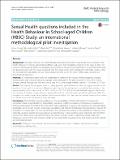Files in this item
Sexual Health questions included in the Health Behaviour in School-aged Children (HBSC) Study: an international methodological pilot investigation
Item metadata
| dc.contributor.author | Young, Honor | |
| dc.contributor.author | Költő, András | |
| dc.contributor.author | Reis, Marta | |
| dc.contributor.author | Saewyc, Elizabeth M. | |
| dc.contributor.author | Moreau, Nathalie | |
| dc.contributor.author | Burke, Lorraine | |
| dc.contributor.author | Cosma, Alina | |
| dc.contributor.author | Windlin, Béat | |
| dc.contributor.author | Gabhainn, Saoirse Nic | |
| dc.contributor.author | Godeau, Emmanuelle | |
| dc.date.accessioned | 2016-12-05T16:31:03Z | |
| dc.date.available | 2016-12-05T16:31:03Z | |
| dc.date.issued | 2016-12-05 | |
| dc.identifier | 248131249 | |
| dc.identifier | d0400ba9-d17b-4226-8229-8155db79b756 | |
| dc.identifier | 85002145917 | |
| dc.identifier | 000390907600002 | |
| dc.identifier.citation | Young , H , Költő , A , Reis , M , Saewyc , E M , Moreau , N , Burke , L , Cosma , A , Windlin , B , Gabhainn , S N & Godeau , E 2016 , ' Sexual Health questions included in the Health Behaviour in School-aged Children (HBSC) Study: an international methodological pilot investigation ' , BMC Medical Research Methodology , vol. 16 , 169 . https://doi.org/10.1186/s12874-016-0270-8 | en |
| dc.identifier.issn | 1471-2288 | |
| dc.identifier.other | RIS: Young2016 | |
| dc.identifier.uri | https://hdl.handle.net/10023/9936 | |
| dc.description | HBSC France is funded by INPES (National institute for Health Promotion and Education) and OFDT (French Monitoring Centre for Drug Use and Addiction). HBSC Hungary is funded by former OGYEI (National Institute of Child Health) (currently NEFI, National Institute of Health Promotion). HBSC Ireland is funded by the Department of Health. HBSC Portugal is funded by DGS (Director General of Health, Ministry of Health). HBSC Romania is funded by the Norway Innovation Grants through the Romanian Ministry of Health. | en |
| dc.description.abstract | Background: This paper describes the methodological developments of the sexual health items included in the Health Behaviour in School-aged Children (HBSC) study since their mandatory inclusion in the study in 2002. The current methodological, ethical and pedagogical challenges in measuring young people’s sexual health behaviours are discussed along with the issues associated with the sexual health items introduced to the HBSC study in 2002. The development and piloting of new cross-national items for use in the 2013/14 HBSC data collection are presented and discussed. Methods: An international pilot study was undertaken to determine the impact of these proposed changes. Questionnaires and classroom discussion groups were conducted in five pilot countries in 2012/2013 (France, Hungary, Ireland, Portugal and Romania) with a total of 612 school-aged children (age M = 15.55 years, SD = 0.95). Results: The majority of participants in each country provided positive feedback about the appropriateness of the questions. Some small cross-national differences were found in the self-reported quantitative data relating to the appropriateness of the questions (χ2 = 22.831, df = 9, p = .007, V = .117). Qualitative feedback suggests that for the vast majority of students the phrasing and age-targeting of the questions were considered appropriate. With the exception of a small number of respondents who commented on the clarity and/or personal nature of the content, no specific issues with the questions were identified. Conclusions: These findings provide guidance on the answerability (including the extent of missing and inconsistent data), understandability, acceptability (including in different cultures) and relevance of questions to potential participants. The findings from the pilot study suggest that in general, the questions are understandable, acceptable, and of a high priority to the target population, and that the simplification has significantly reduced the proportion of missing data. The new developments thus enhance the capacity of the questions to measure cross-nationally, sensitive aspects of young people’s sexual behaviour. These questions were included in the 2013/2014 round of the HBSC survey and will continue to be used to monitor trends in adolescent sexual health and behaviours, and to inform and influence health services and health education policy and practice at local, national and international levels. | |
| dc.format.extent | 12 | |
| dc.format.extent | 1174285 | |
| dc.language.iso | eng | |
| dc.relation.ispartof | BMC Medical Research Methodology | en |
| dc.subject | Adolescent sexual health | en |
| dc.subject | Adolescent sexual behaviour | en |
| dc.subject | Self-completion | en |
| dc.subject | Questionnaire design inconsistencies | en |
| dc.subject | Missing data | en |
| dc.subject | RA0421 Public health. Hygiene. Preventive Medicine | en |
| dc.subject | RJ Pediatrics | en |
| dc.subject | NDAS | en |
| dc.subject | SDG 3 - Good Health and Well-being | en |
| dc.subject | SDG 4 - Quality Education | en |
| dc.subject.lcc | RA0421 | en |
| dc.subject.lcc | RJ | en |
| dc.title | Sexual Health questions included in the Health Behaviour in School-aged Children (HBSC) Study: an international methodological pilot investigation | en |
| dc.type | Journal article | en |
| dc.contributor.institution | University of St Andrews. School of Medicine | en |
| dc.contributor.institution | University of St Andrews. Child and Adolescent Health Research Unit | en |
| dc.contributor.institution | University of St Andrews. WHO Collaborating Centre for International Child & Adolescent Health Policy | en |
| dc.identifier.doi | 10.1186/s12874-016-0270-8 | |
| dc.description.status | Peer reviewed | en |
This item appears in the following Collection(s)
Items in the St Andrews Research Repository are protected by copyright, with all rights reserved, unless otherwise indicated.

